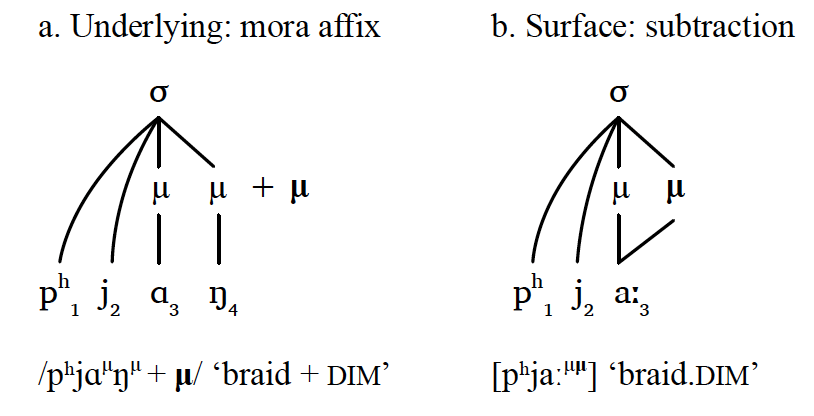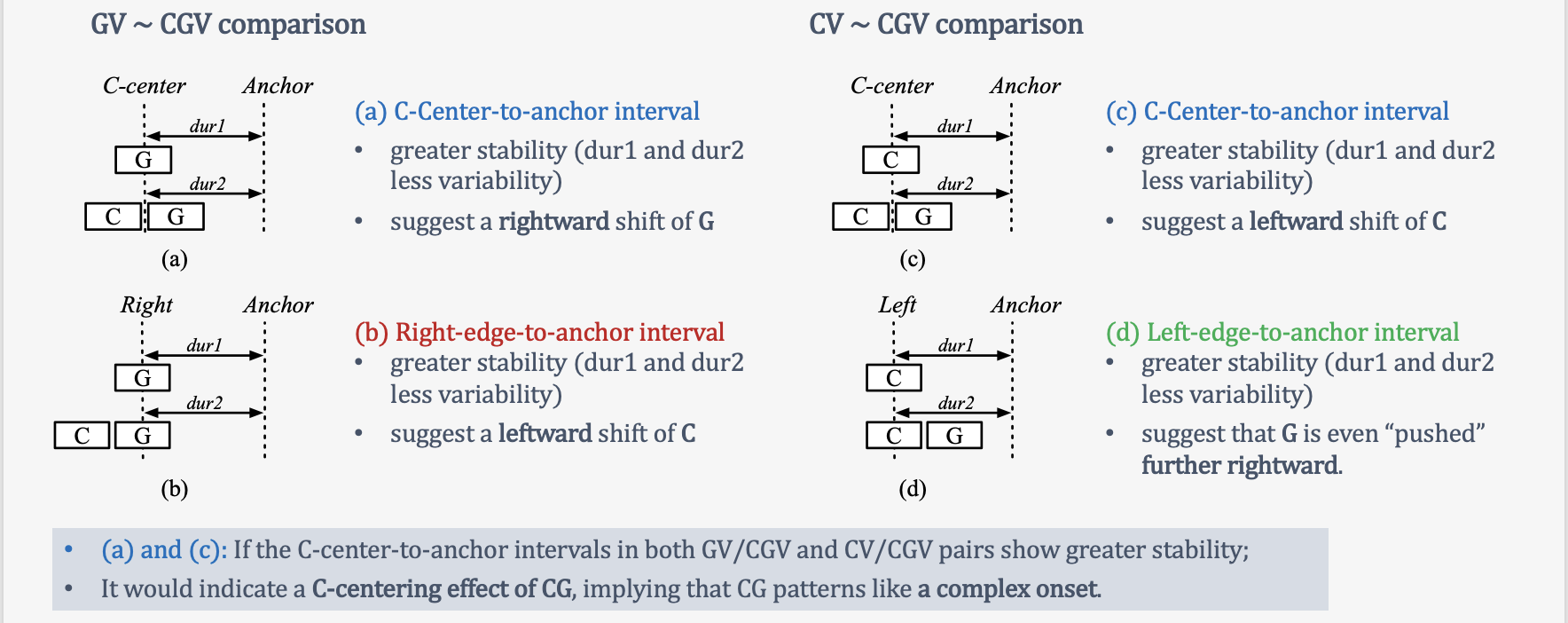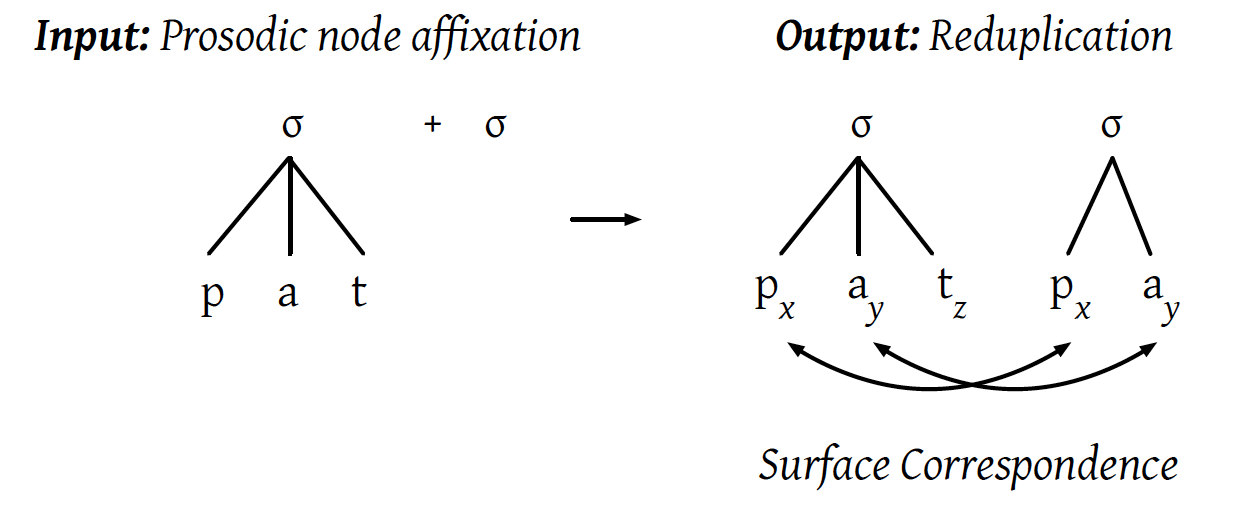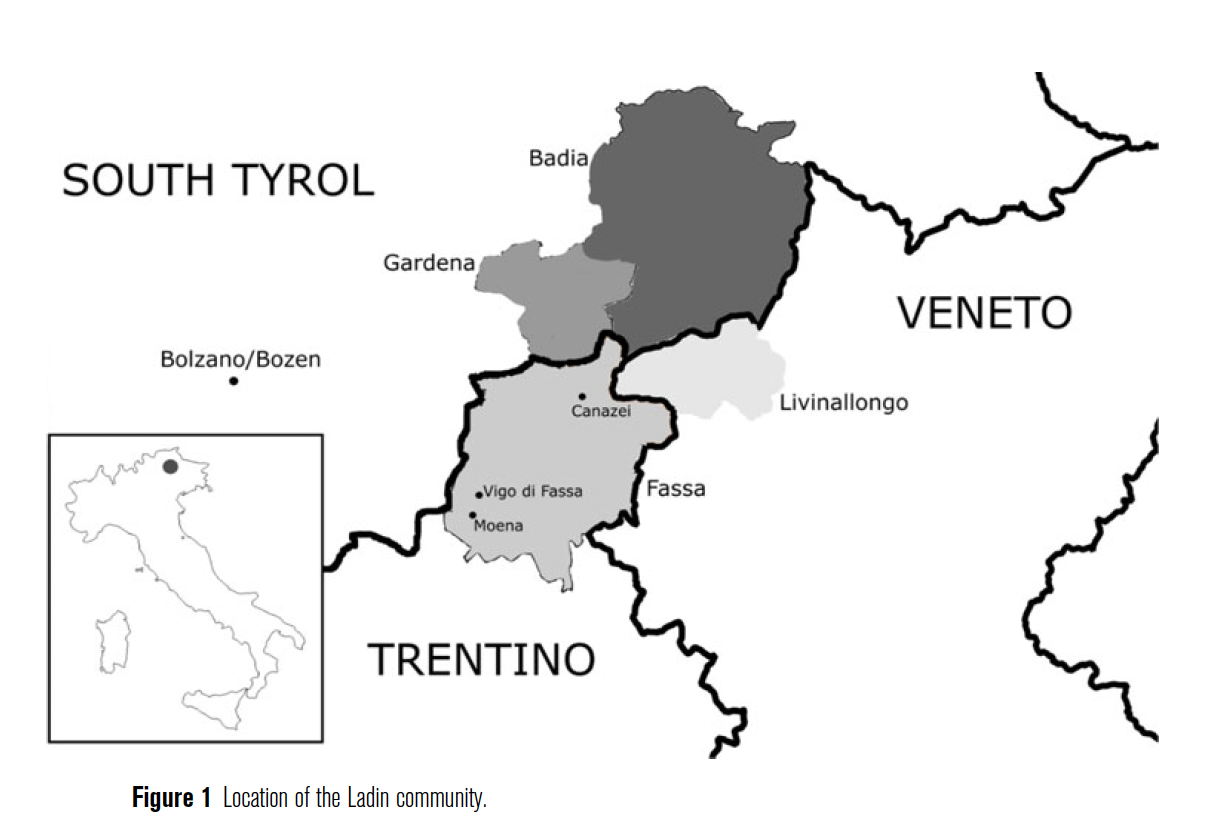Yifan Yang Ph.D. in Linguistics
Research Overview
My work often combines theoretical frameworks with empirical data collected through fieldwork and phonetic analysis, aiming to bridge the theoretical and empirical dimensions of phonology.
Here are my main research topics.
Rime change in Chinese dialects
One of my main research areas focuses on rime change ("变韵" bianyun) in Chinese dialects. Rime change refers to a set of morphophonological alternations involving syllable modifications, including vowel quality changes, lengthening, or segment deletion. This phenomenon is widely attested in northern Chinese dialects. Most of them are commonly used to express diminutive meanings (smallness or cuteness).
My research investigates both the phonological and morphological aspects of rime change. For example, in Yang (2024), I analyze diminutive subtraction in Huozhou Chinese (霍州) as a case of floating mora affixation, offering support for the Item-and-Arrangement model of morphology.
In addition to theoretical analysis, I use acoustic data to document the phonetic realization of rime change in specific dialects, aiming to uncover patterns that may inform our understanding of diachronic development. Several related studies are currently under review or in preparation.

Related Works:
2024. Yang, Yifan. Floating mora affixation in Huozhou diminutive subtraction. Glossa: A Journal of General Linguistics. [Paper].
2023. Mora affixation in nonconcatenative morphology. Talk presented at The 29th Annual Meeting of the International Association of Chinese Linguistics (IACL 29). May 2023, Macau, China (Macau University of Science and Technology).
2016. Zhang, Jisheng & Yifan Yang. 晋豫边界鹤壁地区“子”变韵的音系理据 [Phonological evolution of ‘zi’ rime change on the border of Shanxi and Henan Province: A case study of dialects in Hebi]. In Wei Zheng (ed.), 《边界方言语音与音系演变论集》 [Phonetic and Phonological Changes on Dialect Boundaries]. Shanghai: 中西书局[Zhongxi Press]. (In Chinese) [Paper]
Syllable structure with acoustic measurements
In this line of research, I investigate the syllable structure of various languages and dialects using acoustic measurements. As demonstrated in previous work (e.g., Durvasula et al. 2021), acoustic data can reveal temporal coordination patterns that shed light on syllable organization.
We have applied this approach in our studies of Ladin (e.g., Yang & Walker 2025) and Chinese dialects (e.g., Yang & Qian 2025). In particular, we are currently examining whether this method can offer new insights into a long-standing question in Chinese phonology: the syllabic affiliation of onglides.


Related Works:
2025. Yang, Yifan & Rachel Walker. Temporal coordination in sibilant-stop clusters in Moenat Ladin. Romance minority languages and linguistic theory (RMLLT). Special Issue of Isogloss. Open Journal of Romance Linguistics (Eds. Michela Russo & Shanti Ulfsbjorninn). [Paper]
2025. Yang, Yifan & Qian Zhiheng. Temporal organization of prenuclear glides in Hefei Mandarin. INTERSPEECH 2025. [Paper]
2023. Walker, Rachel & Yifan Yang. Temporal Coordination and Markedness in Moenat Ladin Consonant Clusters. In Noah Elkins, Bruce Hayes, Jinyoung Jo and Jian-Leat Siah (eds.), Supplemental Proceedings of the 2022 Annual Meeting on Phonology. Washington, DC: Linguistic Society of America. [Paper]
Correspondence and reduplicative identity
A central issue in the study of reduplication is whether reduplicative identity requires a formal mechanism like correspondence. My research supports the use of correspondence theory in handling such identity effects. In Yang (2023), I demonstrated that a Harmonic Serialism account fails to analyze the shortening patterns in Rapa Nui reduplication, whereas an analysis based on Base-Reduplicant Correspondence successfully predicts the observed patterns.
Building on this, I further argue that some reduplication-related phenomena are best analyzed within the framework of Agreement-by-Correspondence (ABC; Rose & Walker 2004), which allows for identity to emerge via feature agreement among correspondents. This line of inquiry positions ABC not just as a theory of consonant harmony, but as a more general and versatile grammatical mechanism for modeling identity effects in reduplication.

Related Works:
Accepted. Yang, Yifan. Reduplicative identity driven by Surface Correspondence. Phonology.
2023. Yang, Yifan. Rapa Nui: a case for correspondence in reduplication. Linguistic Inquiry 54(2). 395-412. [Paper].
2019. Generalized Surface Correspondence in reduplication. Poster presented at The 2019 Annual Meeting on Phonology (AMP 2019). October 2019, Stony Brook, NY. [Poster] [Demo sound files]
2018. Backcopying driven by Surface Correspondence. Talk presented at The Workshop on Phonological Variation and its Interfaces. November 2018, Barcelona, Spain. [Presentation handout]
Phonology and phonetics of Ladin
Another major area of my research focuses on the phonetics and phonology of Ladin (ISO 639-3: lld), an endangered Romance language spoken in northeastern Italy. Drawing on fieldwork data collected in 2018 and 2019, we have undertaken a series of studies examining various aspects of Ladin and its dialectal varieties.
Our work includes descriptive analyses of the sound system (Yang et al. 2022), investigations of consonant cluster patterns ( Walker & Yang 2024), and studies on the temporal coordination of word-initial clusters (Walker & Yang 2023; Yang & Walker 2025). We have also conducted acoustic analyses of sibilants in Ladin (Yang et al. 2019).
A current area of focus is the syllabic affiliation of sC- (sibilant-stop) clusters in the Moenat variety, which remains an open question and is the subject of ongoing research (Walker & Yang, in prep).


Related Works:
2025. Yang, Yifan* & Rachel Walker. Temporal coordination in sibilant-stop clusters in Moenat Ladin. Romance minority languages and linguistic theory (RMLLT). Special Issue of Isogloss. Open Journal of Romance Linguistics (Eds. Michela Russo & Shanti Ulfsbjorninn). [Paper]
2024. Walker, Rachel & Yifan Yang. Consonant phonotactics in the Moenat variety of Ladin. Italian Journal of Linguistics 36(1). [Paper].
2023. Walker, Rachel & Yifan Yang. Temporal Coordination and Markedness in Moenat Ladin Consonant Clusters. In Noah Elkins, Bruce Hayes, Jinyoung Jo and Jian-Leat Siah (eds.), Supplemental Proceedings of the 2022 Annual Meeting on Phonology. Washington, DC: Linguistic Society of America. [Paper]
2022. Yang, Yifan*, Rachel Walker, Alessandro Vietti & Armin Chiochetti. Ladin, Varieties of Val di Fassa. Journal of the International Phonetic Association 52(3). 495-520. [Paper].
2022. Temporal Coordination and Markedness in Moenat Ladin Consonant Clusters. Poster presented at The 2022 Annual Meeting on Phonology (AMP 2022). October 2022, Los Angeles. (Co-authors: Walker, Rachel & Yifan Yang.) [Paper] [Poster] [References]
2019. Variation of sibilants in three Ladin dialects. Poster presented at The 3rd Phonetics and Phonology in Europe Conference (PaPE 2019). June 2019, Lecce, Italy. (Co-authors: Yang, Yifan, Rachel Walker, & Alessandro Vietti.) [Poster]
2019. Cumulative markedness in three-consonant clusters. Talk presented at The 14th Old World Conference on Phonology (OCP-14). January 2019, Verona, Italy. (Co-authors: Walker, Rachel & Yifan Yang.) [Presentation slides]